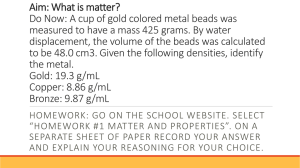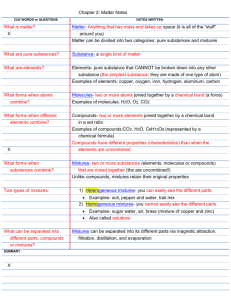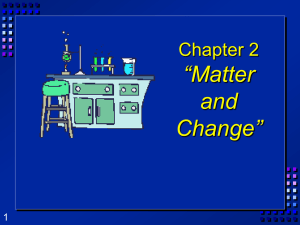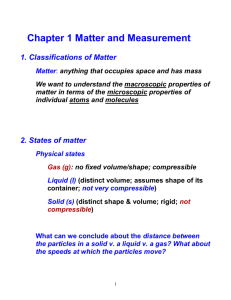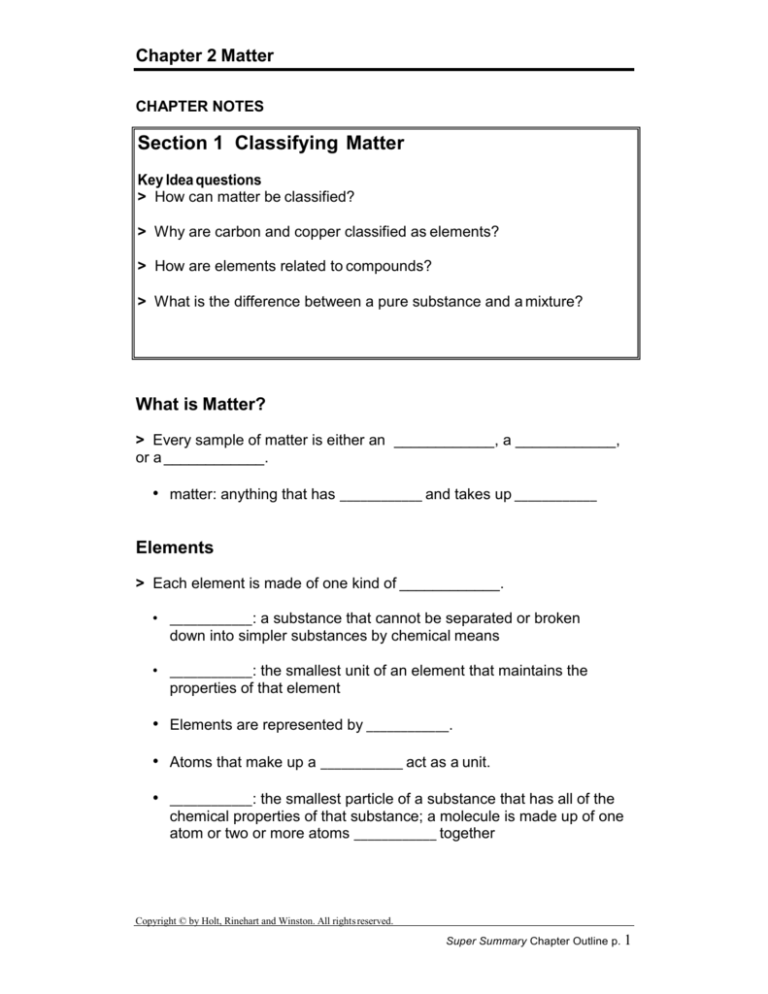
Chapter 2 Matter
CHAPTER NOTES
Section 1 Classifying Matter
Key Idea questions
> How can matter be classified?
> Why are carbon and copper classified as elements?
> How are elements related to compounds?
> What is the difference between a pure substance and a mixture?
What is Matter?
> Every sample of matter is either an ____________, a ____________,
or a ____________.
• matter: anything that has ____________ and takes up ____________
Elements
> Each element is made of one kind of ____________.
• ____________: a substance that cannot be separated or broken
down into simpler substances by chemical means
• ____________: the smallest unit of an element that maintains the
properties of that element
• Elements are represented by ____________.
• Atoms that make up a ____________ act as a unit.
•
____________: the smallest particle of a substance that has all of the
chemical properties of that substance; a molecule is made up of one
atom or two or more atoms ____________ together
Copyright © by Holt, Rinehart and Winston. All rights reserved.
Super Summary Chapter Outline p. 1
Chapter 2 Matter
Compounds
> Each molecule of a compound contains two or more ____________that
are chemically combined.
•
____________: a substance made up of atoms of two or more
different elements joined by chemical bonds
• Compounds have unique properties.
• ____________ ____________represent compounds.
– The following chemical formula represents the compound for
indigo: ________________________
Pure Substances and Mixtures
> Elements and compounds are ____________ ____________, but
mixtures are not.
• pure substance: a sample of matter, either a single element or a
single compound, that has definite ____________ and ____________
________________________
• ____________: a combination of two or more substances that
are not chemically combined
• Mixtures are classified by how thoroughly the substances mix.
substances aren’t mixed
uniformly and are not evenly distributed
– ________________________ mixture:
– ________________________ mixture:
substances are evenly
distributed, and the mixture is the same throughout
– ____________:
substances that can be mixed
– ____________:
substances that cannot be mixed
• Gases ____________ mix with liquids.
Copyright © by Holt, Rinehart and Winston. All rights reserved.
Super Summary Chapter Outline p. 2
Chapter 2 Matter
Section 2 Properties of Matter
Key Idea questions
> Why are color, volume, and density classified as physical properties?
> Why are flammability and reactivity classified as chemical properties?
Physical Properties
> Physical properties are characteristics that can be observed
____________ ____________ the identity of the substance.
• Physical properties can help ____________ ____________.
• Physical properties can be ____________ or ____________.
– Examples: ____________, ____________ , ____________,
____________, ____________, melting point, boiling point, strength,
hardness, magnetism, the ability to conduct electricity or heat
– ____________ ____________: the temperature and pressure at
which a solid becomes a liquid
– ____________ ____________: the temperature and pressure at
which a liquid becomes a gas
• Physical properties help determine uses.
• ____________ is a physical property.
– density: the ratio of the ____________ of a substance to the
____________ of the substance
– common unit of density is ____________.
• Density is different from weight.
Copyright © by Holt, Rinehart and Winston. All rights reserved.
Super Summary Chapter Outline p. 3
Chapter 2 Matter
Chemical Properties
> A chemical property describes how a substance changes into a new
substance, either by combining with other elements or by breaking
apart into new substances.
• Flammability is a chemical property.
– flammability:
____________________________________________________________________
____________________________________________________________________
• Reactivity is a chemical property.
•
– reactivity:
_______________________________________________________________
_______________________________________________________________
Physical and chemical properties are different.
– ____________
____________can be observed without changing the
identity of a substance.
– ____________
____________can be observed only in situations in
which the identity of the substance changes.
Copyright © by Holt, Rinehart and Winston. All rights reserved.
Super Summary Chapter Outline p. 4
Chapter 2 Matter
Section 3 Changes of Matter
Key Idea questions
> Why is getting a haircut an example of a physical change?
> Why is baking bread an example of a chemical change?
> How can mixtures and compounds be broken down?
Physical Changes
> A physical change affects one or more properties of a substance
without changing the identity of the substance.
• physical change:
___________________________________________________________
___________________________________________________________
• Physical changes do not change a substance’s identity.
– Examples of physical changes:
__________________________________________________________
__________________________________________________________
• Dissolving is a physical change.
Chemical Changes
chemical change:
____________________________________________________________
____________________________________________________________
Chemical changes happen everywhere.
–
Examples of chemical changes:
_________________________________________________________
_________________________________________________________
Chemical changes form new substances.
Copyright © by Holt, Rinehart and Winston. All rights reserved.
Super Summary Chapter Outline p. 5
Chapter 2 Matter
Chemical changes can be detected.
–
Signs include:
________________________________________________________
________________________________________________________
________________________________________________________
Chemical changes ____________ be reversed by physical changes.
Breaking Down Mixtures and Compounds
> Mixtures can be separated by ____________ changes, but compounds
must be broken down by ____________ changes.
Examples of separating a mixture:
–
Separating saltwater into its parts by heating it: When the water
____________ , the salt remains.
–
Using a ____________ device to heat a mixture whose
components have different boiling points: The component that
boils and evaporates first separates from the mixture.
–
Using a ____________: The mixture spins rapidly until the
components separate.
Some compounds can be broken down through ____________ changes.
Examples of separating a compound:
–
When mercury(II) oxide is heated, it breaks down into the
elements ____________ and ____________ .
–
When a current is passed through melted table salt, the elements
____________ and ____________ are produced.
–
When you open a bottle of soda, carbonic acid in the soda breaks
down into ____________ ____________ and ____________.
Copyright © by Holt, Rinehart and Winston. All rights reserved.
Super Summary Chapter Outline p. 6



